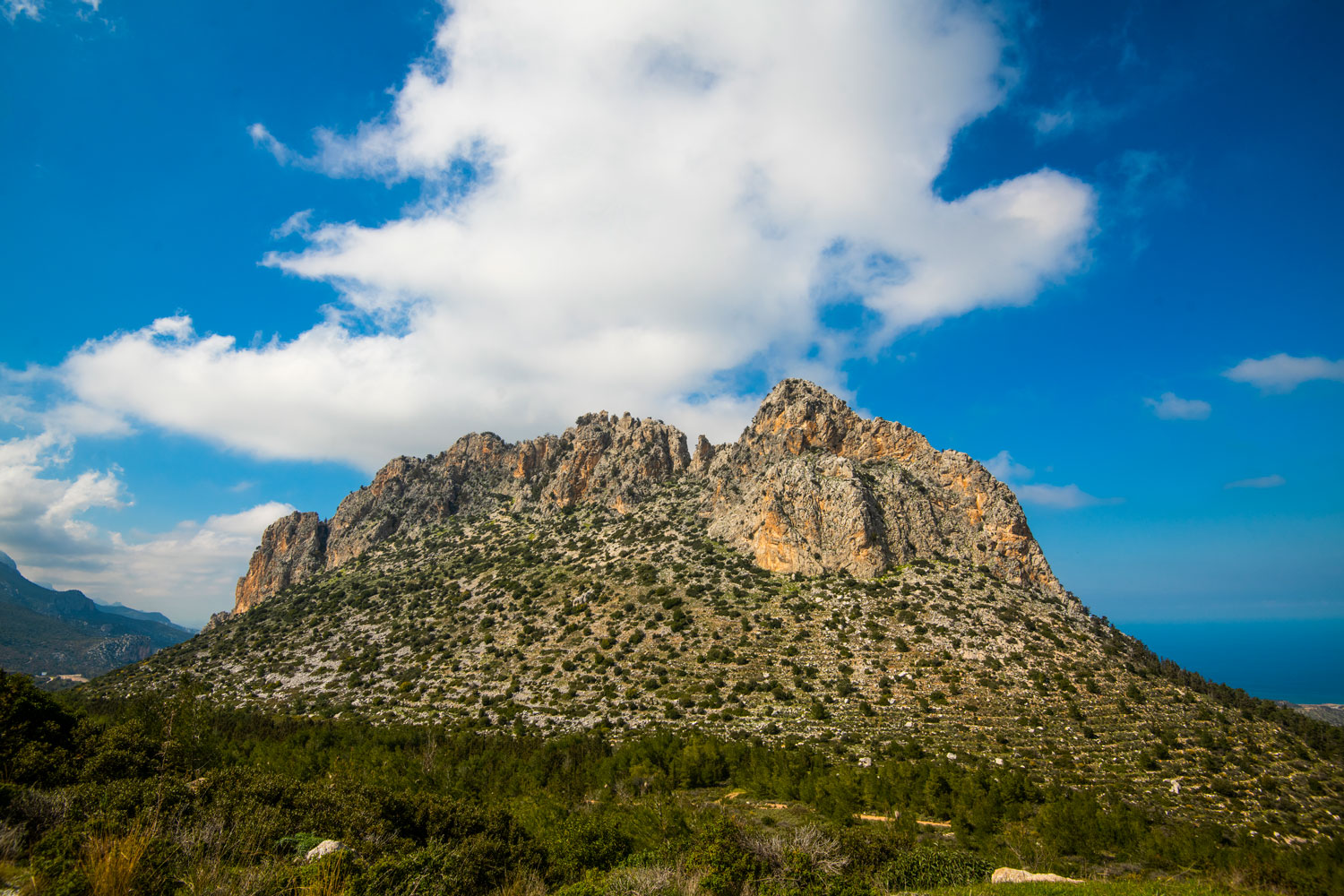


One of only two mountain ranges on the island, its highest peak is Selvili Tepe, at just over a thousand metres. It is primarily made of limestone, including dolomite and marble dating to the Mesozoic period. Clothed in pine and cypress forests, including a selection of deciduous trees, Arbutus, Holm Oak, Azarolus, Fig and Walnut are all well spread and frequent. Furthermore, the range is an area of diverse flora, many of them endemic species and a source of delight to all botanists whether amateur of a professional.
There are three main passes in this rugged mountain range through which most traffic is routed, though there are other tracks that take a more circuitous route and are used by keen walkers and hikers, especially those undertaking the various stages of the famous Besparmak Mountain Trail. During the time of the Byzantines and Lusignans, the location of these mountains near the sea made them desirable locations for watch towers and castles overlooking the coast and central plain. Castles sat astride of peaks during the Middle Ages that today attract thousands of visitors each year are the St. Hilarion, Buffavento and Kantara.
Despite its relatively low altitude, the abruptly risen range provides an effective barrier between the Mesarya Plain and the northern coastline, preventing harsh winds from drying the fertile soil that fills this agricultural area. Any winter rain irrigates the plain and provides nourishment for the crops, and the porous limestone provides an excellent filter for the water that is preserved in the mountain aquifers. It is this mountain range that provides the water for nearly all the towns and villages in North Cyprus. An abundance of fire breakers run alongside the mountain slopes, established after a destructive forest fire in 1996 which continued for three days and destroyed a large part of the Kyrenia forestry and habitat.
A giant flag of the Turkish Republic of Northern Cyprus is also painted on the southern slope of these mountains – at 425 metres wide and 250 metres high, this flag can be seen from kilometres southwards and is illuminated at night. The Besparmak’s most distinguishing feature is a peak that resembles five fingers with several differing legends explaining how this came about. Have a read of a few below.
The Legendary Tales:
love and duel
A long time ago a pretty girl lived in a village on the outskirts of Kyrenia. Two men were both very much in love with this dame, but only one would receive her affection. One’s heart was made of gold, the other’s however full of evil. Tired of trying to outwit one another for her heart, the men decided to settle for a duel in a close by marshland. The malevolent man quickly wounded the other and threw his opponent into the swamp, quickly being dragged down into the deep swamp. The goodhearted man in a last grasp somehow managed to drag his opponent in as well, and both were buried alive. The gentleman however was entombed with his left fist tightly quenched above the mud, yearning in desperation his love would save him. When the marshy area dried out and the man’s hand turned into the mountains and today, we can see his knuckles and five fingers on the Besparmak range!
gutsy love
A gutsy villager fell in love with the local queen and asked for her hand in marriage. For most, this would stay an unrequited love, but the villager, who it’s fair to say was a little bit arrogant, confronted the queen nonetheless. The queen wished to be rid of the rude man and requested that he bring her some water from the spring of Apostolos Andreas Monastery in the Karpaz, quite a risky journey in those days, deemed an almost impossible mission. The man set off and after several weeks managed to return with the precious water, much to the dismay of the queen. Although he had succeeded, nevertheless the queen still refused to marry him. In a fit of rage, he poured the water onto the earth, seized a handful of the resulting mud and threw it at the queen’s head. She dodged the lump of mud which sailed far across the land all the way to the top of the Kyrenia mountain range, where it is to this day, still showing the impression of the thwarted villager’s five fingers or a representation of the heartbroken villager’s disappointment.
Digenis Akritas
Another famous tale is of the Byzantine hero Digenis Akritas. Tradition has it that the bold warrior leapt across the sea from Anatolia in a magnificent attempt to save Cyprus from the Saracen invaders. Hand gripping the mountain to get out of the sea, it is his heroic handprint in the mountains.
handful of rocks
According to another legend, the gnarled massif was formed millions of years ago when the world was peopled by giants. A giant aiming a handful of rocks at his opponent missed their target and the rocks landed on the hillside, forming the limestone five-finger ridge!
